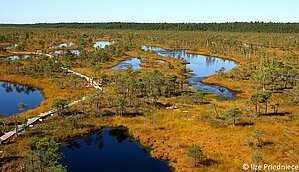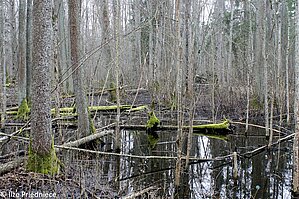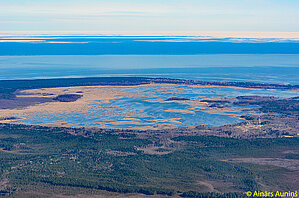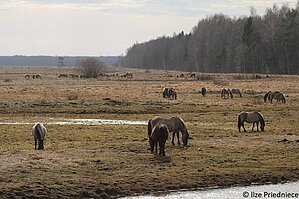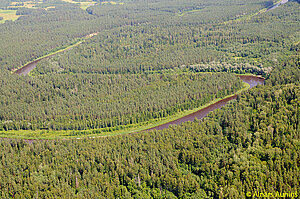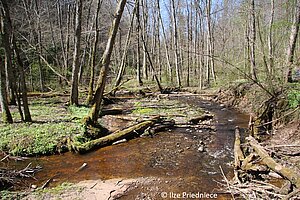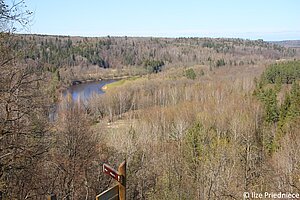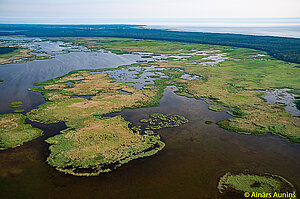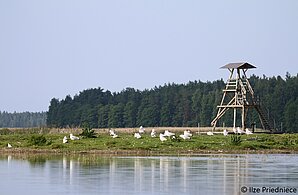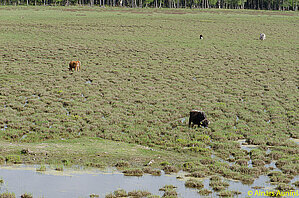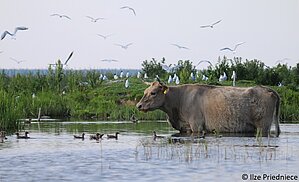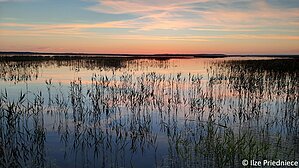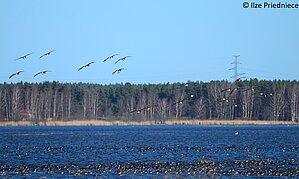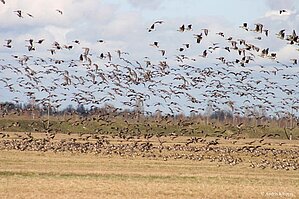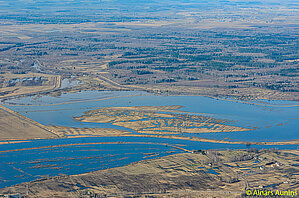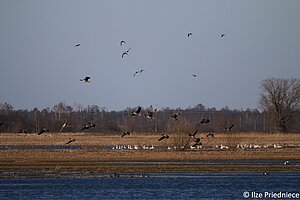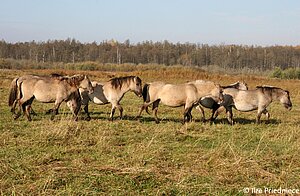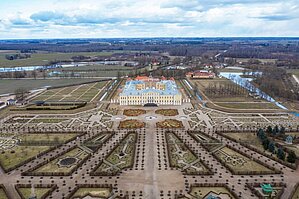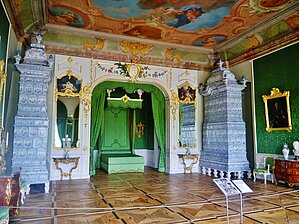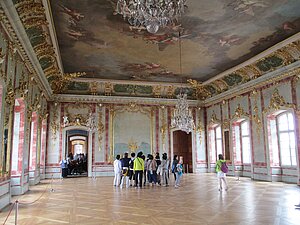Excursion day: 3 April
We offer 5 very different excursions on Thursday, April 3:
Excursion 1: Ķemeri National Park
Ķemeri National Park is the third largest national park in Latvia in terms of area. It is known for its great biodiversity, unique Ķemeri bog, mineral waters and medicinal mud. The park is characterised by a diverse world of wetlands, including raised bogs, fens and transitional bogs, which cover 24% of the park's area. The Great Ķemeri Bog is one of the largest in Latvia. 57% of the park is covered by almost continuous forest. Most of the bogs and forests in the park have been untouched by man for a long time and are home to unique flora and fauna.
A total of 255 bird species have been recorded in Ķemeri National Park. The forests in Ķemeri National Park are very diverse, ranging from old pine stands to wet deciduous and mixed forests, and are home to eight species of woodpecker (Great Spotted Woodpecker, Middle Spotted Woodpecker, Lesser Spotted Woodpecker, White-backed Woodpecker, Three-toed Woodpecker, Black Woodpecker and Grey Woodpecker), 6 owl species (Tawny Owl, Pygmy Owl, Long-eared Owl, Short-eared Owl, Tengmalm's Owl and Eagle Owl) and species associated with forest-marsh complexes such as Nightjar.
The reed beds of Ķemeri National Park are home to species such as Great Bittern, Little Crake, Reed Warbler, Great Reed Warbler, Savi’s Warbler, Bearded Tit and Red-necked Grebe.
Because the bogs have been untouched by man for a long time, they consist of hummock-lake complexes, which allow many bird species to breed, and include open areas that make them important resting places for migratory birds, such as Common Crane and several species of geese.
During the excursion you may see waders, such as Lapwing, Golden Plover, Common Snipe, Common Sandpiper, Wood Sandpiper, Green Sandpiper, Common Redshank, Spotted Redshank, Whimbrel, Curlew, Bar-tailed Godwit, Black-tailed Godwit, and Ruff. You may also see species such as Woodlark, Stock Dove, Great Grey Shrike, Teal, Hazel Grouse, Black Grouse, Common Crossbill, Parrot Crossbill and gulls such as Black-headed Gull, Little Gull, Common Gull and Herring Gull. You may also see birds of prey such as Sparrowhawk, Common Buzzard, White-tailed Eagle and, if you are lucky, Black Stork.
Ķemeri National Park is also home to 47 species of mammals, including 9 of the 16 species of bats found in Latvia, as well as wolves and lynx.
Read more about Ķemeri National Park here.
Excursion 2: Gauja National Park
Gauja National Park is the oldest and largest national park in Latvia. It is located along the valley of the Gauja River, which gives the park its name. It is characterised by great biodiversity, diverse landforms, natural springs, Devonian sandstone outcrops, scenic views and unique natural, cultural and historical monuments. Along the Gauja River you can see reddish, yellow and greyish sandstone formed 350-370 million years ago. There are many caves in the national park, including Gūtmaņala, the largest cave in the Baltic States. Since 2004, it has been part of the Natura 2000 network as an area designated for the conservation of protected species and habitats.
Gauja National Park is home to almost 900 species of plants, 147 species of birds and 52 species of mammals. Forests cover 47% of the park's territory and are home to many protected bird species.
Sandstone outcrops provide habitat for Kingfisher and Sand Martin, while rapids of streams - for Grey Wagtail and Dipper. During the excursion you may also see Common Goldeneye, Goosander, Tufted Duck, Common Sandpiper and Green Sandpiper.
In the forests you can hear and see typical species such as Goldcrest, Firecrest, Eurasian Treecreeper, Eurasian Nuthatch, Eurasian Wren, Eurasian Robin, Dunnock, Tree Pipit, all the local species of tits, Nutcracker, Song Thrush, Blackbird, Mistle Thrush, Redwing, Fieldfare and also seven woodpecker species (including Middle Spotted Woodpecker, Three-toed Woodpecker, White-backed Woodpecker). If you are lucky, you may also see protected species such as Black Grouse, Hazel Grouse, Black Stork, Pygmy Owl, Lesser Spotted Eagle and White-tailed Eagle.
Other species such as Capercaillie, Eagle Owl and other owl species are also present in the Gauja National Park, but the chances of seeing them are not very high.
As for mammals, twelve out of sixteen species of bats have been recorded in the park, as well as bears, lynx and wolves. It is very likely that you will see many traces of beaver and wild boar.
Read more about Gauja National Park here
Excursion 3: Lake Engure Nature Park
The nature park lies at the coast of the Gulf of Riga and its central feature is a shallow coastal lake with its surrounding habitats. A protected area was established there in 1957 for the protection of birds. In 1989, the lake was included in the list of Important Bird Areas in Europe. Ornithological research has been carried out on the lake since 1958, focusing on the population ecology of the Black-headed Gull, Tufted Duck, Common Pochard, Northern Shoveler and many other waterbirds. Lake Engure is the largest lagoon lake in Latvia - it is a shallow and naturally eutrophic lake with an average depth of 0.4 m. The surroundings of Lake Engure are biologically diverse in all respects - 28 habitats of EU importance have been found here - forest, grassland, freshwater, wetland and many other habitats. More than 870 vascular plants have been found, of which 55 are specially protected species.
186 species of breeding birds have been recorded, so almost all bird species migrating along the Gulf of Riga can be observed in the park, with an emphasis on wetland birds - ducks, waders, etc. Lake Engure Nature Park is home to various birds of prey, such as White-tailed Eagle, Lesser-Spotted Eagle, Honey Buzzard, Osprey, Common Buzzard. Contiguous forests provide habitat for birds such as Black Stork, Eagle Owl, 8 out of 9 Woodpecker species found in Latvia including Three-toed Woodpecker, Black Woodpecker and White-backed Woodpecker.
The reedbeds of Lake Engure are full of birdlife - Great Bittern, Little Crake, Spotted Crake, Great Reed Warbler, Savi's Warbler, Bearded Tit and many other species can easily be heard. Greylag Geese, Mute and Whooper Swans, Red-necked Grebes, Great Crested Grebes and many species of ducks use the open water areas of the lake.
Coastal meadows are grazed year-round by semi-wild cattle and horses ('koniks'), maintaining areas suitable for wading birds – Common Redshank, Black-tailed Godwit, Common Snipe, Lapwing, Ruff, Common Crane breed here. Even a nest of the Southern Dunlin has been found on the meadow. During migration, the meadows are full of birds that come to feed and rest. They are used to people - the nature trail leads through the area and ends with a bird-watching tower where you can watch the birds from the top. All the time you spend there, the voices of Black-Headed Gulls will be in your head, as one of the largest breeding colonies in Latvia is less than 300 metres from the tower.
Lake Engure Nature Park is home to 42 species of mammals, of which the American mink and the Racoon dog are having serious negative impact on the the ground-nesting birds (being one of the causes of steep decline in Black-Headed Gull population)
Read more about the Lake Engure Nature Park here
Excursion 4: Lake Babīte and the floodplains of Lielupe and Svēte Rivers
Lake Babīte is an eutrophic freshwater coastal lake, rich in emergent vegetation, less than an hour's drive from the centre of Riga. The site is tightly enclosed by polder dikes and surrounded by farmland. A small area of wet natural meadows remains in the SW part. In 1989, the site was included in the list of Important Bird Areas in Europe, and in 2004, the Babīte Lake Nature Reserve was included in the Natura 2000 network. The polders around the lake host important concentrations of birds during the spring migration. In the area, 70 protected breeding bird species have been recorded.
The floodplains of Lielupe and Svēte rivers are located in the south-central part of Latvia and are part of the Lielupe Meadows Nature Reserve. The reserve was established to protect northern boreal alluvial meadows - more than 95% of the area is covered by this habitat type. In spring, when the ice and snow melt, the flooded meadows attract thousands of migratory birds. During the breeding season, Spotted Crake, Black-Tailed Godwit, Common Redshank, Ruff, Little Crake, Great Snipe and many other bird species can be observed here.
During the spring snowmelt, the central part of Latvia is a great place for geese, ducks and waders to concentrate, as it is an important place to feed and gain energy for further migration. During the busiest migration period, the floodplains host tens of thousands of geese (Great White-fronted Goose, Tundra and Taiga Bean Goose, Barnacle Goose, Greylag Goose, Brent Goose and even Red-breasted Goose) and ducks (Pintail, Northern Shoveler, Gadwall, Garganey, Eurasian Teal etc.). Waders such as Lapwing, various species of shanks and plovers use the puddles in the fields to feed. In the midst of the quiet feeding, birds of prey (Merlin, several species of harriers, Sparrowhawk and others) try their luck and prey on the small birds. Only the appearance of the White-tailed Sea-eagle can disrupt soothing honking of the geese, causing chaos and confusion in the polders and fields.
Excursion 5: Rundāle Palace
Rundāle Palace is the most important baroque palace in Latvia. The palace was designed by the Italian architect Francesco Rastrelli and built between 1736 and 1768 as the summer residence of the Duke of Courland Ernst Johann Biron. The palace has undergone several renovations over the years. During the First World War, the German army used the palace as its headquarters. In 1923, the rooms of the palace were used by the primary school of Rundale parish. After the Second World War, when Latvia was occupied by the Soviet Union, the palace rooms were used as grain storehouses. In 1963, some rooms of the palace were given to the Regional Art Museum of Bauska (the nearest larger town), but in 1972 a permanent museum was established at Rundāle Palace with the aim of restoring the palace to its 18th-century appearance. The full restoration of the palace was not completed until 2014.
The Rundāle Palace Garden was designed by the architect Francesco Rastrelli during the construction of the palace (1736-1740). Rastrelli's garden design, with its complex network of avenues, boskets and pergolas, is similar to the structure of the gardens at Versailles. The park at Rundāle Palace was not affected by the 19th century European trend towards landscape parks rather than formal gardens. By 1739, 32,818 linden trees, 500 chestnut trees, 188 oak trees and many others had been planted in the Rundāle Palace Garden. There are 2230 varieties of roses, including 600 historic varieties. The park was regularly maintained until the First World War, when it became overgrown. After the Second World War, a sports ground with a pond in the middle was built on the parterre. The linden trees of the central avenue were felled.
The Rundāle Palace ensemble covers an area of 85 hectares, including the palace and stables, the French Baroque garden, the former hunting park, orchards, the pond and canals, the foundations of the old Grotthuss mansion from the 16th century...
If you want to learn more about Latvia's Baroque pearl, Rundāle Palace, and see which species of birds have chosen the French garden as their home, listen to the Blackbird trying to match French notes, and watch the White Stork dancing in its nest near the palace, choose this excursion (more information on the museum's website and Wikipedia)!
The tour will be led by an official guide of the Palace.
